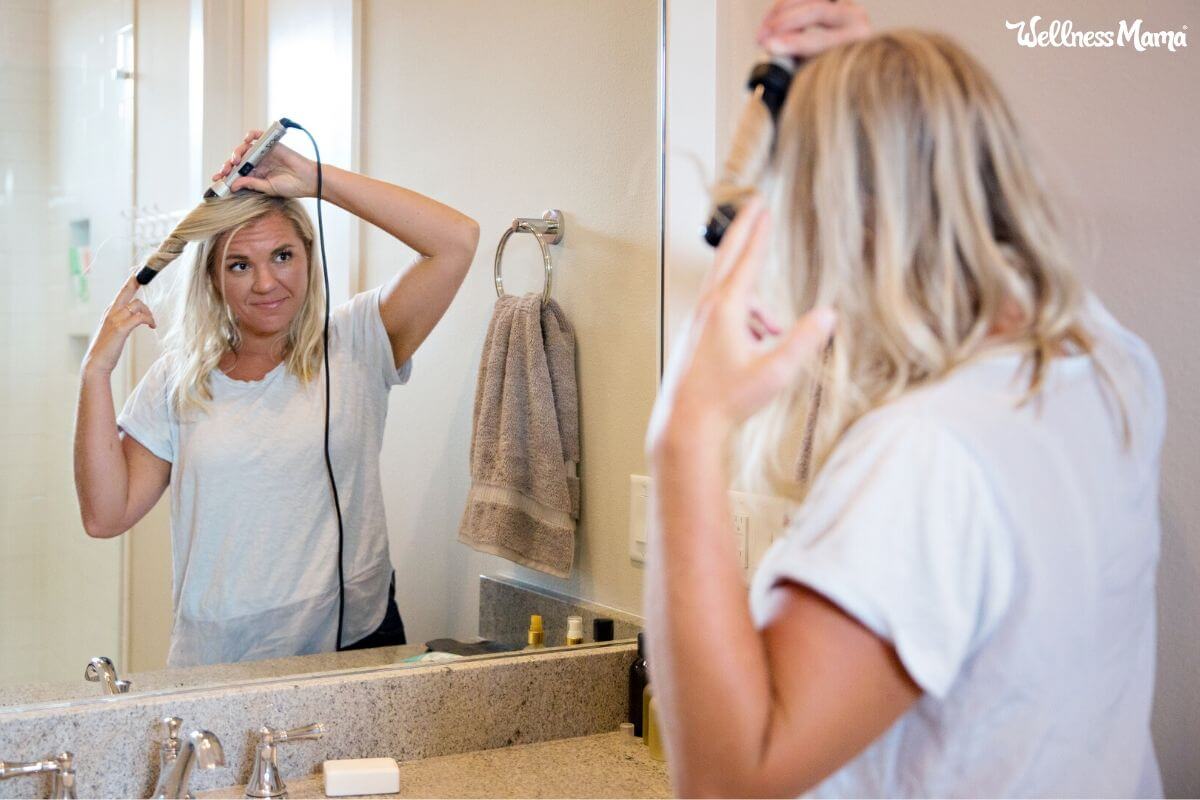Let’s face it: no matter how au naturale we are, most of us still want to walk out of the house with bouncy, gorgeous hair.
Unfortunately, this effect most often requires the help of damaging heating tools like blow dryers, curling irons, and straighteners. If you’re no stranger to these tools, you probably use some kind of protectant spray to avoid heat damage.
While it’s a great idea to protect your strands from harm, here’s a better, natural option that doesn’t contain harsh chemicals.
Heat Spray Chemicals to Avoid
Most commercial heat protectant sprays (as well as shampoos, conditioners, and other cosmetics and beauty products) contain toxic chemicals that can be inhaled or absorbed through your pores. Here are a few common ingredients that could be dangerous to your health.
1. Acrylates
Acrylates, or copolymers, are used to create a film over your hair to relieve static. They are also used in nail polish and other hair styling products to promote “hold.” Unfortunately, they have also been listed as possible carcinogens.
2. Quaternium-70
Also referred to as “quats,” this class of chemicals are positively-charged particles that can attach to hair to provide a layer of protection. However, they may not bode well for your health: the EWG lists the popular quat, quaternium-70, as a possible immunotoxin, and is linked to developmental and reproductive issues.
3. Dimethicone
Dimethicone is a type of silicone often used in cosmetics, including heat protectant sprays. Silicones help provide sheen with protection, while also protecting hair color from heat. Like quats, however, dimethicone is classified as harmful by the Environment Canada Domestic Substance List and is recommended by the EWG to be restricted in cosmetics.
4. Hydroxypropyl Polysiloxane (Hydrolyzed Wheat Protein)
Interestingly, peptides from wheat protein are also common in hair styling products. If you’re gluten-free or paleo, it might be important to avoid this—even though a gluten reaction to these peptides is rare. Even so, heavy metals like arsenic have also been found in hydrolyzed wheat protein. Studies recommend keeping hydrolyzed wheat protein away from your nose, mouth, and any damaged skin, which can be difficult if you’re spraying a heat protectant spray so close to where it could accidentally be inhaled.
Natural Heat Protectant Ingredients
Fortunately, you don’t have to give up your heating tools. Natural, moisturizing oils and essential oils can help reduce static and nourish strands while providing a light barrier to heat. Here’s a breakdown of the ingredients in our homemade heat protectant spray—and why they work.
Coconut Oil
We start with a base of coconut oil in this recipe because of its high heat tolerance. Just like when you’re cooking, if you’re applying heat to an oil, you want to make sure it doesn’t degrade and cause damage to your body (or your strands!).
Here’s another great reason to use coconut oil on your hair: One of coconut oil’s main fatty acids, lauric acid, can penetrate deep inside your hair shaft to provide deeper protection and moisture. For the same reasons, coconut oil is great for your skincare routine, especially if you have rashes or acne.
Although coconut oil usually solidifies at cool temperatures, I haven’t had that issue with this recipe. If you are concerned, try fractionated coconut oil instead.
Almond Oil
Almond oil also stands up well against heat, which bodes well when using items like curling irons and straighteners. Plus, it contains plenty of nourishing vitamin E!
Essential Oils
While there are no direct studies showing essential oils can protect hair from heat specifically, many people claim they help keep your hair and scalp strong and balance oil production. Studies have found that geranium oil, which is included in this recipe, can help hair grow faster.
We also use clary sage in this blend because it is reputed to help strengthen hair and make it more resistant to breakage. Like geranium, studies show its linalyl acetate content may help increase hair growth.
Natural Heat Protectant Spray
Equipment
Materials
- 1 cup water (divided)
- 1 tsp coconut oil (melted or fractionated)
- 1 TBSP almond oil
- 5 drops clary sage essential oil
- 5 drops geranium essential oil
Instructions
- Add half a cup of the water to the spray bottle.
- Pour in the melted coconut oil, almond oil, and essential oils.
- Shake well.
- Add the rest of the water and shake again until thoroughly combined.
- Shake the bottle before each use to mix the oils.
- To use: Spritz the bottom half of hair 1-2 times depending on thickness (not too much, as the oils are deeply moisturizing and too many sprays can overly coat your strands!) and work through your ends.
- Style as usual.
Notes
Other Tips to Strengthen Your Strands
Along with topical protection, you may be able to strengthen your hair from the root down by making sure your diet is rich in certain nutrients. This can ultimately help your hair withstand heat and breakage from the inside out.
Here are the most important vitamins you need to transform brittle hair into strong, shiny locks:
- Vitamin A. A vitamin A deficiency can result in hair loss. Vitamin A helps with the production of sebum, which helps keep hair moisturized. Eat more egg yolks and yellow veggies like carrots and pumpkin to keep your hair looking naturally shiny.
- B vitamins. Similarly, studies have linked brittle hair and hair loss to a deficiency in B vitamins, specifically biotin. Supplement with a B complex or up your intake of meats and seafood.
- Vitamin C. Vitamin C is crucial for producing collagen, the major component that makes up our hair, skin, and nails. Try making bone broth, consuming gelatin, or consider taking a collagen supplement.
- Vitamin D. If you’re low on Vitamin D, you might be facing hair loss. Get a healthy dose of sun exposure every day. That means just 10-15 minutes with no sunscreen!
- Use the right products. Natural products have a reputation for not being as effective, but I set out to change all that! My line of Wellnesse hair products is not only a safe option for families, but we designed them to nourish scalp and strands deeply with ingredients that are like “superfood” for hair.
This article was medically reviewed by Dr. Robert Galamaga, whois a board-certified internal medicine physician. As always, this is not personal medical advice and we recommend that you talk with your doctor or work with a doctor at SteadyMD.
Do you use a heat protectant before styling? Will you try this recipe? Let me know what you think!



Leave a Reply